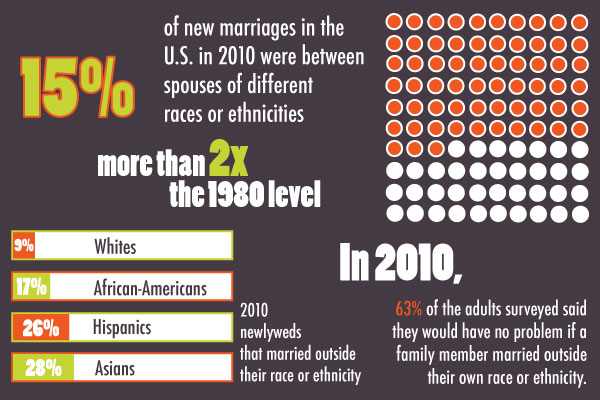
Senior Jennifer Wilkins and her boyfriend have learned to adapt to being out in public as an interracial couple.
“At first we were both uncomfortable with how people looked at us, but then at the same time we just ignore them. We are each other’s strength,” Wilkins said. “If one person is falling, we just have to be like, ‘Hey, we are in this together. It’s not only you. It’s me too.’”
Wilkins, who is Liberian and is dating senior Josh Burrs, who is white and attends Northwestern College, said she agreed when Carol Bruess, director of family studies, gave one main reason why interracial couples are still making news 45 years after the Supreme Court lifted the interracial marriage ban.
“I think it still makes news because it’s really hard for some people to be in an interracial relationship because society still responds to that relationship in many ways as if it’s not normal,” Bruess said.
For senior Sarah Tinsman, who is white and is dating senior Kamal Mohamed, whose mother is Ethopian and father is Egyptian, the stereotypes that people continue to hold are puzzling.
“I think there is that kind of stereotype, that view, that interracial relationships are so much different than same-race. I mean, they’re not. It’s not like we’re some random species that we have our own thing going on,” Tinsman said.
A study by the Pew Research Center found that most people agree with Tinsman.
According to the study, interracial marriage is on the rise and so is the acceptance of it. The study found that 15 percent of all marriages in 2010 were interracial marriages and 63 percent of the people surveyed said it would be acceptable if a family member married outside of their own race or ethnicity.
Wilkins said she can relate to what the study states.
“His family—they accept me, but there is extended family that are like, ‘Really?’ That whole idea of like, ‘No, you don’t do that. You don’t mix the two,’” Wilkins said.
While some aspects of relationships, like meeting a significant other’s family, are challenging enough, Bruess said adding in the interracial or intercultural dynamic can make it even more difficult.
“Simple questions like,‘What’s it like to be dating someone who is different than you?’ ‘What’s it like?’ Imagine being asked those types of questions,” Bruess said. “I think that anytime we have a spotlight or a lens put on us that adds a layer of visibility, a layer of vulnerability… we might act differently.”
For Wilkins and Tinsman, these challenges are worth it because of their feelings for their boyfriends.
“He’s super nice. If I need something or need help, he’s quick to help me figure it out, and he’s a good balance,” Wilkins said.
“We’re just regular, young, college-educated, motivated, fun-loving people, who are attracted to each other, and we enjoy each other’s company,” Tinsman said. “That’s the end of it.”
For Bruess, the results of the study and people like Tinsman and Wilkins are indicators that society is moving in the right direction.
“Even though we still live in a racist society, many of us in far greater numbers than ever are understanding that we’re all humans and everybody is valuable,” Bruess said. “That is the really beautiful thing.”
Olivia Detweiler can be reached at detw5520@stthomas.edu.
Graphic created by Katie Souba.

